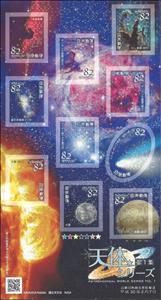Mini Sheet: Celestial Bodies (Series I) (Japan 2018)
Celestial Bodies (Series I) (Japan 2018)
07 February (Japan ) within release Celestial Bodies, Series 1 goes into circulation Mini Sheet Celestial Bodies (Series I) face value 820 Japanese yen
| Mini Sheet Celestial Bodies (Series I) in catalogues | |
|---|---|
| Michel: | Mi: JP 8958-8967FB |
Mini Sheet is vertical format.
Also in the issue Celestial Bodies, Series 1:
- Stamp - Mercury face value 82;
- Stamp - Venus (part) face value 82;
- Mini Sheet - Celestial Bodies (Series I) face value 820;
- Stamp - Wabbling cloud (part) face value 82;
- Stamp - Hale-Bopp comet face value 82;
- Stamp - Sun (part) face value 82;
- Stamp - Orion great nebula (part) face value 82;
- Stamp - Orion great nebula (part) face value 82;
- Stamp - Orion theatrical site near Iota star face value 82;
- Stamp - Star formation area S106 face value 82;
Mini Sheet Celestial Bodies (Series I) it reflects the thematic directions:
A comet is an icy, small Solar System body that warms and begins to release gases when passing close to the Sun, a process called outgassing. This produces an extended, gravitationally unbound atmosphere or coma surrounding the nucleus, and sometimes a tail of gas and dust gas blown out from the coma. These phenomena are due to the effects of solar radiation and the outstreaming solar wind plasma acting upon the nucleus of the comet. Comet nuclei range from a few hundred meters to tens of kilometers across and are composed of loose collections of ice, dust, and small rocky particles. The coma may be up to 15 times Earth's diameter, while the tail may stretch beyond one astronomical unit. If sufficiently close and bright, a comet may be seen from Earth without the aid of a telescope and can subtend an arc of up to 30° (60 Moons) across the sky. Comets have been observed and recorded since ancient times by many cultures and religions.
The Moon is Earth's only natural satellite. It orbits at an average distance of 384,400 km (238,900 mi), about 30 times the diameter of Earth. Tidal forces between Earth and the Moon have over time synchronized the Moon's orbital period (lunar month) with its rotation period (lunar day) at 29.5 Earth days, causing the same side of the Moon to always face Earth. The Moon's gravitational pull – and to a lesser extent, the Sun's – are the main drivers of Earth's tides.
Outer space (or simply space) is the expanse that exists beyond Earth's atmosphere and between celestial bodies. It contains ultra-low levels of particle densities, constituting a near-perfect vacuum of predominantly hydrogen and helium plasma, permeated by electromagnetic radiation, cosmic rays, neutrinos, magnetic fields and dust. The baseline temperature of outer space, as set by the background radiation from the Big Bang, is 2.7 kelvins (−270 °C; −455 °F)
A star is a luminous spheroid of plasma held together by self-gravity. The nearest star to Earth is the Sun. Many other stars are visible to the naked eye at night; their immense distances from Earth make them appear as fixed points of light. The most prominent stars have been categorised into constellations and asterisms, and many of the brightest stars have proper names. Astronomers have assembled star catalogues that identify the known stars and provide standardized stellar designations. The observable universe contains an estimated 1022 to 1024 stars. Only about 4,000 of these stars are visible to the naked eye—all within the Milky Way galaxy.
The Sun, also known as Sol, is a star at the center of the solar system. It is a white star that gives off different types of energy such as infrared energy (heat), ultraviolet light, radio waves and light. It also gives off a stream of particles, which reaches Earth as "solar wind". The source of all this energy is nuclear fusion. Nuclear fusion is the reaction in the star which turns hydrogen into helium and makes huge amounts of energy. It is a nearly perfect ball of hot plasma.





